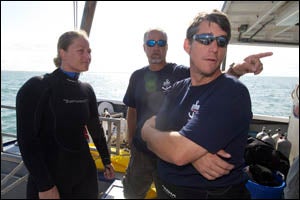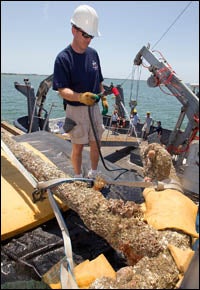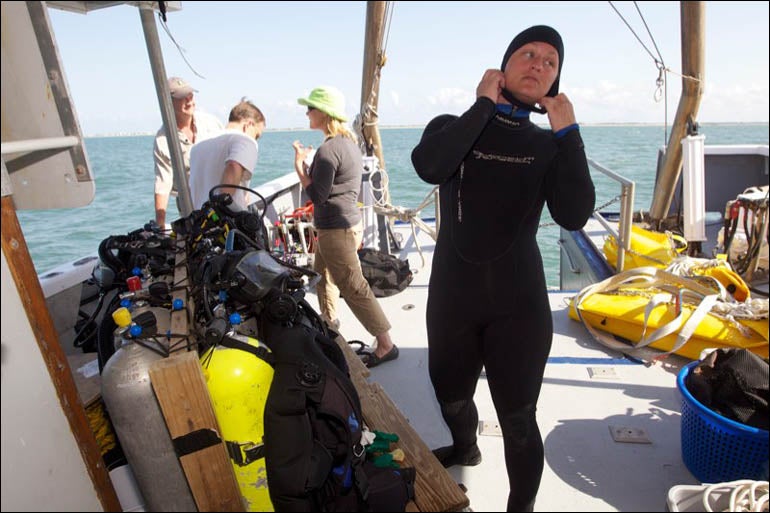Blackbeard’s anchor raised near Beaufort, now at QAR lab
After resting at the bottom of Beaufort Inlet for almost 300 years, one of four large anchors of Blackbeard’s flagship Queen Anne’s Revenge hit the warm Carolina sun again May 27. The anchor’s raising was met with cheers from the crew that has worked for the past nine years to carefully bring the wreckage of Queen Anne’s Revenge to the surface, piece by piece.
This latest find, hailed as significant because of its size and the clues to pirate life that may be in the minerals that encase it, also focused attention on the detailed role of the QAR Conservation Lab at East Carolina University, where the anchor’s secrets will be painstakingly unlocked.
On the day the anchor came up, divers used straps to secure the approximately 2,500 pound anchor to lift bags that were inflated underwater and brought the anchor about 25 feet to the surface.

Wendy Welsh, manager of the QAR Conservation Lab; Cape Fear captain Jay Styron; and Chris Southerly, assistant state archaeologist, plan the first dive to retrieve the anchor from the Queen Anne’s Revenge.
“It was so slow coming up that I just rode it to the surface,” Chris Southerly said later aboard the Cape Fear, a research vessel from UNC-Wilmington used for the project. Southerly is assistant state archaeologist and one of the dive supervisors for the underwater archaeology branch.
Southerly and fellow diver Wendy Welsh high-fived each other and hugged when they were onboard. “What a relief that’s over,” said Welsh, still dripping from their third and final dive. Welsh is conservation lab manager at the QAR Conservation Lab, housed at ECU’s west research campus.
Blackbeard’s Queen Anne’s Revenge wrecked off North Carolina’s coast in 1718. It lies today in protected state waters.
Tension was high as Southerly and Welsh worked to transfer the ropes attached to the anchor to the Dan Moore, a research vessel from Cape Fear Community College so it could be raised. It took two attempts to get the anchor aboard; the first try didn’t bring the anchor close enough to the Dan Moore.
The Cape Fear circled around, pulling the anchor in its lift bags back beside the Dan Moore, and finally the crane hook was lowered down. Southerly attached the hook and up the 2,500 pound anchor went, swaying as the boat rocked from the ocean swells.
Finally, it settled into place on deck at 11:35 a.m. and cheers erupted from those onboard both vessels. Cries of “It’s huge!” and “Yes!” could be heard onboard the Cape Fear. The anchor measures 11 feet long and 7 feet, 7 inches from tip to tip on the fluke. Its outside ring attached to the center shank measures 24 inches in diameter.
“It’s a satisfying day,” Southerly said, after the final dive as he looked at the Dan Moore about 50 yards away preparing to head back to the N.C. State Port with the anchor aboard.
The anchor brought up May 27 is one of three about the same size in the main wreckage pile; a slightly smaller catch anchor lies about 450 feet south. One of the anchors still has some wooden stock in place, Southerly said. Twelve more cannons still remain in the wreckage as well.
“This anchor was on top of the pile. There are six cannons in the main ballast pile,” he said. “Most objects are blobs of concretion. Ceramics, glass beads, slate beads, cuff links, smaller personal items will all be in concretion when we bring it up,” said Southerly, who earned a master’s degree in maritime history and underwater archaeology from ECU in 2003.
“The personal items offer glimpses of lifestyle, how people lived and help to figure out their story,” said Southerly.
The QAR team has about three seasons – 12 weeks each – to get the artifacts up, Southerly said. “Archaeology continues in the lab. What we take up as one object, that one object might have 50 to 100 pieces in it what have to be cleaned and stabilized,” he said.
When they come to the water’s surface, the objects are surrounded by concretion, the solid mass of mineral deposits, which must be removed along with the soluble salts in the metal to make the object stable to be studied, handled and displayed.
Southerly estimated that conservation of the entire collection of QAR artifacts will take 10 to 15 years. X-rays are taken of the items as they are retrieved from the ocean floor and brought to the lab to prioritize what is conserved first, he said.
Initial fieldwork at the site began in 1996, and it has progressed slowly and methodically, he said.
“Once we knew what needed to be done, we had to get a full conservation lab set up and established because you have to have somewhere for the artifacts coming up to go and be stored, treated and stabilized so they don’t deteriorate before they can go to the museum,” Southerly said.
Charles Ewen, professor of anthropology at ECU, was on the Cape Fear and watched as the anchor was brought up. He said the research and vast number of items matching the date of the QAR leaves little doubt of the artifacts’ origin.
“A few years ago, a couple of colleagues in the maritime studies program and another in a book on the archaeology of piracy that I wrote questioned whether this was indeed the Queen Anne’s Revenge, saying maybe some of the archaeologists had jumped the gun a little bit on it. And I think that was a great thing for them to do. It challenged everybody’s assumptions and it kicked the project into higher gear, more specialists were brought in,” said Ewen, who is co-editor of “X Marks the Spot: The Archaeology of Piracy.”
“I think we’re at the point now, several years later, where we’ve got the data, it’s the right size ship, it’s in the right place, dates to the right time period, and there are no other documented candidates that are even close to being this, so I think you have to say the rebuttal presumption, the working hypothesis, is the Queen Anne’s Revenge. The burden of proof has shifted over to the naysayers,” he said.

Myron Rolston, assistant conservationist at the QAR Conservation Lab at ECU, prepares the anchor for its journey to the lab near Greenville after it was lifted from the waters near Beaufort Inlet on May 27.
Ewen said the main bell found at the shipwreck site had a date on it of 1705 and since Blackbeard’s QAR is documented to have sunk in 1718, the bell fits nicely into the puzzle.
“But it just didn’t have the ship’s name on it. I don’t think there’s any single key clue that will say, ‘Ah! We’ve got it!’ What you have to look at is the amalgamation of the data together and taken as a whole, I just think the conclusion is that this is the Queen Anne’s Revenge is almost inescapable,” Ewen said.
The Queen Anne’s Revenge originally was a French slave ship, La Concorde, measuring 90- to 100-feet long with three masts and a crew of 150 to 200. Blackbeard captured La Concorde in 1717 and renamed it before it ran aground in 1718 near what is today Fort Macon State Park.
Southerly said, “This is a fantastic site to work on…. because it went down from grounding, everything is still pretty much where it was on board so we can get a context, a glimpse into the lives of the sailors onboard.
“This is an early 18th century wreck and there haven’t been that many found, especially this intact, on the East Coast or in the Americas. That alone makes it a relatively significant find. Then you add the association with piracy, the slave trade and Blackbeard, it just adds to the story,” Southerly said. “The more we bring up from the wreck site – and we have about half of the site recovered at this point – the more pieces to the puzzle we get, the more clues we get to fill in what history doesn’t give us.”
From Beaufort, the anchor made a brief stop in Morehead City for tourists and locals to see it before heading to the QAR Conservation Lab and a holding tank because it has to stay wet until it’s stabilized, Southerly said.
Mark Wilde-Ramsing, the expedition director and state underwater archaeologist, was visibly relieved and pleased when the anchor was loaded from the Dan Moore and secured on a truck bed for transportation to the lab. He has served as director of the Queen Anne’s Revenge project since it began in 1997. Wilde-Ramsing earned his doctorate in coastal resource management at ECU in 2009.
“This is one of the biggest artifacts on the site,” he said. “I love it because anchors represent ships and seafaring. This is a beautiful example and has beautiful features.”
The clock is ticking to pull artifacts from the wreckage. “We want to start bringing these pieces up off the main mound because we have a directive for three years to do full recovery as hard as we can, to get it all up. It’s about 50 percent of the site out there,” he said.
“This anchor was one of a number piled up in the main ballast area. So bringing this up gave us an idea of what it’s going to take to untangle this concentration,” he said.
Wilde-Ramsing said he liked that the anchor served as a physical representation of what archaeologists do. Artifacts don’t appear from the ocean floor after 300 years in pristine condition. “We’re not finding a lot of gold, not the booty that they think Blackbeard buried somewhere else, but here are the real artifacts connected to what Blackbeard was doing.”
“(The anchor) will go on public viewing for a few lucky people today. But to see these artifacts the way they are – they are kind of stinky, kind of hard to see – that’s what archaeologists start with and what you see at the other end, in four or five years with this anchor, is a beautiful, clean artifact just like Blackbeard left it when he sank,” he said.
Wilde-Ramsing said scientists from across the state work on the project, and he singled out Cape Fear Community College and UNC-W’s research vessels and ECU’s efforts in the project. “The biggest support is from East Carolina University, which houses our conservation lab. That’s nine-tenths of the work on any archaeology project is in the conservation lab,” he said.
Not only does ECU provide lab space, Wilde-Ramsing said, but also the university provides students and staff from the maritime studies program to help in the lab and also experts from multiple departments across campus. “We have chemists, biologists, textile experts and the list just goes on, coming out.”
